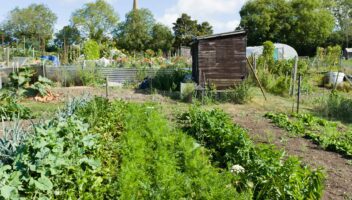Companion planting can bring a number of great benefits to the garden. Companion planting can be a successful way to combat a variety of pests for those who prefer to use minimal or no plant protection products in their garden. Some plants act as natural deterrents, while others attract beneficial insects that are the natural predators of less-wanted visitors. Companion plants can also add a touch of pretty colour to your vegetable patch or allotment. If you wish to see those plants that can repel bugs then look no further.
View our collection of plantsThe following plants offer a natural deterrent to some of the less desirable creatures that attack crops:
Marigolds
Plant marigolds in your vegetable patch to deter whitefly and attract ladybirds, which will help control aphids. They also emit a substance from the roots that deters damaging nematode worms in the soil.
Nasturtiums
Plant nasturtiums alongside your brassicas to attract cabbage white butterflies away from your precious greens. They are also good near beans and peas, as aphids will naturally be drawn to the nasturtiums instead. Nasturtiums’ leaves and flowers have the added bonus of being a tasty and vibrant addition to your salads.
Pungent vegetables
Plant pungent vegetables, such as onions, garlic or chives next to your carrots to deter carrot fly.
Aromatic herbs
Plant aromatic herbs, such as rosemary, sage, dill and mint alongside broccoli or lettuce. Their scent will deter a number of common and unwanted insects that might otherwise eat them. Be cautious when planting mint; it can easily become invasive in a vegetable patch. Planting it in a pot and sinking the pot into the ground is a good way to keep it under control.
Borage
Borage is a fantastic companion plant. It can act as a repellent to tomato hornworm if planted near your tomato plants. It is also considered one of the best plants to position near strawberries, deterring many of the pests that would attack them, including by attracting the pollinators that naturally prey on these pests, as well as improving the flavour of the strawberries.
Basil
Plant basil near tomato plants and peppers. It will deter flies as well as increase the yield.
Bee-loving plants
Plants that are loved by bees, such as lavender and dahlias, can attract these wonderful pollinators that, in turn, will pollinate your tomatoes, cucumbers, aubergines, peppers, strawberries and more. Position them near where you are growing your plants or in a pot beside the greenhouse door.

The value of companion planting goes beyond the helpful, natural pest-deterrent properties of plants. As a form of polyculture (as opposed to monoculture), growing certain plant species together can bring benefits that are sometimes mutually experienced. Examples of this are:
- Carrots and tomatoes. When grown in the same space, carrots aerate the soil, helping the tomato plant get more water to its roots. In return, the tomato plant will offer much-needed shade for your carrots as they grow.
- Sweetcorn needs a good supply of nitrogen in order to produce the best yield. Plant together notorious nitrogen-fixing plants – in particular, peas and beans (of any variety) – that are excellent at converting nitrogen in the air into nitrogen trapped in bacteria in the soil, helping your sweetcorn grow.





